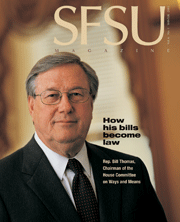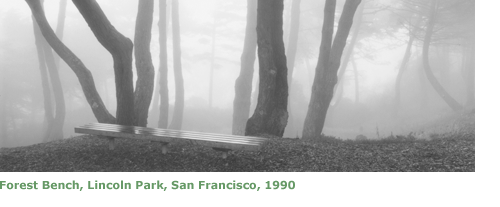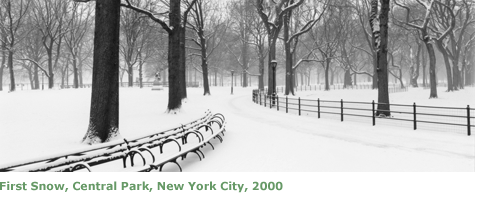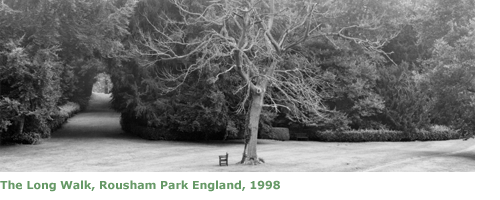 |
| |||
Behind the Lens: In Search of Eden "Jack liked to rattle cages—that's their job at graduate school, to shake you up," Gomes says one fall afternoon at his South San Francisco home, wearing a smile beneath his silvery moustache. "And he'd say, it takes, on average, 10 years after graduate school before an artist produces anything of value." But in fact, it took Gomes nine. One September morning in 1989, Gomes hauled his camera to San Francisco's Presidio at the first light of day. As soon as he printed his photograph, "San Francisco Presidio #1," he knew he'd captured something meaningful. A panoramic view of a wooded intersection, the silvery image has a mystical quality. Marks of human intervention dot the grove of stately trees—a speed limit sign, a cyclone fence. An empty road stretches into the misty distance. The beauty in the photograph is of an odd sort of naturalness, hovering between the raw and the manicured.
"San Francisco Presidio #1" became the seed of a 16-year project, "Imagining Eden," just out in book form from the University of Virginia Press. In it, Gomes finds a vision of Eden not just in the Presidio, but in English gardens, a snow-covered Central Park and even the 15th hole of San Mateo's Peninsula Golf Club. Supported by a Fulbright Scholar Award and a Rockefeller Foundation residency, the series took Gomes from Oakland's Lakeside Park to Italy's Lake Como in search of an eerie serenity. "There's a tension that creates an energy in the landscape, and the tension is, I think, that they're human-made places that use nature as a model," Gomes says of the locales that inspired him. In the Presidio photographs, for instance, "from one angle the trees look orderly, and from another they look random," Gomes says. "And I play off that tension in the photographs." Gomes' commitment to landscape photography began during his years as an SFSU undergrad. In 1975, he transferred to the University from the College of San Mateo, where he had taken his first photography class and where he now teaches, because he was attracted to the work of Welpott and another popular teacher, Don Worth. Gomes still talks to Worth several times a month. "San Francisco State was an exciting place, because both Don's and Jack's careers were so active," Gomes says. "And I knew I wanted to combine education and art-making in my career, as they had." Gomes' teachers immediately recognized that they had an exceptional student. "He was so committed," says Worth, now an SFSU professor emeritus of art. Gomes' graduate student portfolio consisted of what he calls landscape abstractions: "It would look like a mountain, but it was really a piece of aluminum," he says. After graduate school, he was working with "primordial landscapes"—pristine, untouched canyons—when he took a photo with a small boat in it and realized he responded to "the human element in the landscape." His next breakthrough was technical: After long admiring the panoramic photographs of Josef Sudek, Gomes took his own bellowed camera and masked the ground-glass and film holder to frame his narrow rectangular view. Six months later, he took "San Francisco Presidio #1," and shortly after that he took "Atget's Bench, Lincoln Park." "That's when I realized it wasn't just one place, the Presidio, but a type of place," he says. His modern-day Edens are glades of peace and comfort: Almost all of the images were shot in the early morning, and under foggy conditions, with no harsh shadows to disturb the haze of tranquility.
Now, after 16 years of pursuing Eden, he is excited to see his work turning a new direction. His latest photographs, taken on Italy's Lake Como, are abrupt juxtapositions of architecture and landscape, close-up croppings of geometrical walls and dappled lake views that resemble painterly diptychs. Gomes thinks the new series might take two or three years to complete, a fraction of the time spent on "Imagining Eden," and nowhere near the long years required to make his first work of any value. Looking back on that near-decade of apprenticeship, he's grateful for the prodding of his SFSU mentors. When he saw his former professor Jack Welpott at a retirement party, he told him, Rachel Howard is the author of "The Lost Night," a memoir about her father's unsolved murder, and writes about the arts for the San Francisco Chronicle. | ||||












